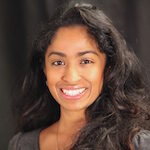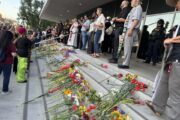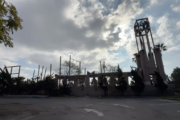Anna Stephens was on a humanitarian mission to Sudan with the International Red Cross when she first read The Power of Now: A Guide to Spiritual Enlightenment by Eckhart Tolle. For Anna, raised Catholic in a suburban community in Connecticut, the book was her first foray into contemporary Eastern spirituality. Five years later and now living in West L.A., Anna finds her life deeply immersed in the do-it-yourself practices of spiritual awakening. Along with the daily home practice of Insight meditation, she also connects with others through weekly Hatha yoga classes in Venice Beach, an occasional ten-day silent retreat at the Southern California Vipassana Center in Joshua Tree or the Insight Meditation Society (IMS) in Barre, Massachusetts. She also schedules regular checking-in time with her spiritual counselor in Berkeley via Skype.
But while Anna’s life seems in many ways imbued with spirituality, and though she may incorporate various ideas about Karma and Metta (loving-kindness) into her personal spiritual worldview, when asked what religion she identifies with, she would be reluctant to affiliate herself with any particular group or movement. Her type of religious un-affiliation is a growing phenomenon in the United States. A recent Pew poll found that one-fifth of the U.S. public – and a third of adults under 30 – are now religiously unaffiliated “nones” – a 15 percent increase in just the past five years. In fact, 37 percent of this group of “nones” classify themselves as “spiritual but not religious.”
One of the spiritual practices that’s flourishing among this particular segment of the “nones” is Insight, or Vipassana, meditation. Although based on Buddhist principles of self-transformation through self-observation to gain insight into the impermanence of the self, Vipassana meditation is being introduced with minimal reference to its Buddhist roots into wellness programs, anger management courses, grade-school curricula, addiction and recovery treatment and other therapeutic settings as method of stress reduction, pain management and self-understanding.
An explosion of research on the neuroscience of mindfulness has also supported the growing popularity of meditation, with research centers at UC San Diego, UCLA and elsewhere focused on fostering mindful awareness through education and research.
But apart from these secular-medicalized spheres of meditation, the American meditation movement is most significantly propagated and shared with people like Anna by lay teachers, who distribute their books and podcasts and hold retreats in places that are not typically associated with the “traditionally religious.” In such contexts, meditation is proffered as a personal and inward affective experience, unaccompanied by dogma, hierarchies of authority, issues of cultural preservation or even concern for the forging of communal bonds. As such, these practitioners are much more likely to describe their involvement with implicitly Buddhist practice as “spiritual” but not “religious.”
While spirituality without religion appears to be a new phenomenon today, the historical emergence of contemporary Eastern spirituality movements like Vipassana in the 1970s suggests that the groundwork for this type of spirituality was laid by counter-culture segments of earlier generations. These Baby Boomer seekers traveled to other parts of the world to learn meditative disciplines under the tutelage of Asian teachers who were part of this 20th century modernization movement. As Jack Kornfield, one of the senior American Vipassana teacher, has said, “We wanted to offer the powerful practices of Insight meditation, as many of our teachers did, as simply as possible without the complications of rituals, robes, chanting and the whole religious tradition.”
One of the purposes of the CRCC’s Religious Competition and Creative Innovation project is to identify and research religious congregations and organizations in Southern California that are innovating in the ways in which they practice, organize, interpret and communicate their religious faith, and also how they relate to other groups (within their faith and outside their faith tradition).
As we explore the multifaceted religious landscape of the region, we are sure to encounter networks of spiritual practice emerging around observances like Insight meditation and yoga that do not fit easily or unambiguously with what is recognized as “properly religious.” Indeed, there seems to be a move away from theistic orthodoxies to alternative spiritual sensibilities, many of which are taking place in the personal domain, largely outside of institutional influence.
As the Pew Center’s research shows, “roughly three-in-ten religiously unaffiliated adults say they believe in spiritual energy in physical objects and in yoga as a spiritual practice. About a quarter believe in astrology and reincarnation. In addition, nearly six-in-ten of the religiously unaffiliated say they often feel a deep connection with nature and the earth; about three-in-ten say they have felt in touch with someone who is dead; and 15% have consulted a psychic.”
In light of these findings, some of the questions we might then consider in this study are how these trends relate to the diminution of institutionalized religious practice in America and, furthermore, how are churches, temples, synagogues and mosques responding to these changes in American spiritual/religious life? What we may find is that the nature of these responses are powerfully shaping innovation within religious institutions.
Nalika Gajaweera was a senior research analyst with the USC Center for Religion and Civic Culture through 2023.








